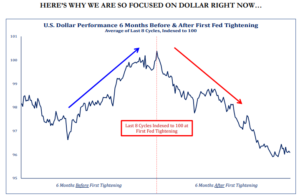Looking Back at Asset Class Performance in 2021
January 7, 2022
To Inform:
The first week of the year is a time to look back, compile the official market data for the prior year, see what worked and what did not work, and use it all to inform decisions for the year ahead. Let’s look at some observations across major asset classes.
Note: Index Return data from Morningstar Workstation as of 12/31/2021.
U.S. Stocks:
- Perhaps the most popular index in the world, the S&P 500, had a terrific year in 2021, and was up over 28%. As a result, the S&P 500 provided the biggest positive contribution to diversified portfolios.
- Taking a wider view than the largest 500 stocks saw lots of variation beneath the surface. The Russell 2000, an index of small company stocks, started 2021 outperforming, but lagged large company stocks by over 14% in the final six months of the year and finished the year with a return of +14.8%.
- Not every investor in large U.S. stocks was successful. Investors who thought technologically innovative stocks were the place to be were proven wrong in 2021. A wildly popular exchange traded fund (ETF) consisting of innovation stocks (and had phenomenal performance in 2020) finished the year with a return of -23.6%. Performance here suggests a lesson to us that chasing the performance of prior winners is NOT necessarily a successful investment strategy.
Foreign Stocks:
- The MSCI EAFE (Europe, Australasia, and Far East), an index of developed market foreign stocks, showed momentum in December and finished the year with a return of +11.3%, while the MSCI EM Emerging Market Index struggled, posting a return of -2.5%.
- When we look at foreign stocks, the most interesting thing to us is the impact of the U.S. Dollar. In general, when the value of the U.S. dollar rises against other currencies, the impact on foreign stocks is negative and vice versa. When we dig into EAFE, the index return was +11.3%, but the return on the stocks in the index (based on a currency hedged EAFE) was +19.6%. In 2021, the value of the dollar increased and had a negative -8.3% performance impact on foreign stocks.
- Why is the dollar impact important? In a recent call a fund manager said to us, “if the dollar weakens in 2022, the anchor on portfolios (foreign stocks) could turn into a rocket ship.” We are noting not only are foreign stocks cheaper than U.S. stocks at the widest levels in over a decade (based on P/E ratios), but research shows the dollar tends to weaken when the Fed starts to hike interest rates (see chart below). We’re laser-focused on this relationship as we approach 2022.

Source: Strategas Research Partners
Bonds:
- Speaking of Fed rate hikes, current market data forecasts the Fed will raise rates four times in 2022. Whether this happens remains to be seen, but Fed rate hikes represent a major headwind for bonds as bond prices fall when rates rise (and vice versa).
- In 2021, the Bloomberg U.S. Aggregate Bond Index lost money, finishing the year with a total return of negative -1.5% as rates rose from the historically low levels where they started the year.
- Inflation-protected bonds as measured by the Bloomberg U.S. Treasury TIPS (Treasury Inflation Protected Securities) Index rose +6% due to higher inflation rates. Since inflation is a major factor we consider when constructing objective-based strategies on behalf of our clients, many strategies we manage contain a strategic allocation to TIPS.
Real Assets:
- Another tool we use to combat inflation in objective-based portfolios is an allocation to a basket of Real Assets consisting of commodities, global real estate, and infrastructure.
- Commodities (think oil, wheat, copper, silver) are direct inputs to production and are perhaps the most sensitive asset class to inflation. Commodity performance, as measured by the Bloomberg Commodity Index was +27.1% in 2021.
- Global Real Estate (think office buildings, shopping malls, industrial warehouses, and data centers) struggled in 2020 due to COVID’s impact on real estate but came back to return +21.4% in 2021 based on the Dow Jones Global World Real Estate Index.
- Global Infrastructure (think cell towers, toll roads, airports, utilities) finished 2021 with a +19.9% return as measured by the Dow Jones Brookfield Global Infrastructure Index.
- As we head into 2022, we believe a diversified basket of Real Assets continues to be a powerful tool to combat the prospective challenges of high inflation.
The S&P 500 Was the Leader in 2021, Do We Think It Continues in 2022?
The Joseph Group’s Investment Strategy Team has wrestled with this question as we enter the new year. Here are some facts:
- The 10 largest stocks make up approximately 30% of the index – the highest concentration in the Top 10 stocks in over 30 years.
- The two largest stocks have a combined weight of over 11.5% in the index. This kind of concentration has never happened in over 30 years of data on the index.
- Years ago, oil and gas represented 13% of the index while software represented 3%. Today those percentages are flipped with software representing 10% of the index and oil and gas representing a mere 2.5%.
Looking at these facts, we recognize the impact of a few large stocks and especially the technology sector on the construction of the S&P 500. The prospects of these areas may determine the ultimate outperformance (or underperformance) of the index. We especially note the math of higher interest rates is a headwind to technology stock valuations which is a key factor we are weighing as we approach 2022.
We wish you and your loved ones all the best in 2022 and we look forward to keeping you informed as we navigate the 2022 market environment.

Written by Travis Upton, Partner, CEO and Chief Investment Officer